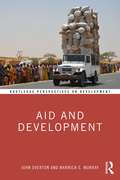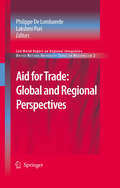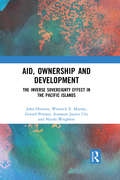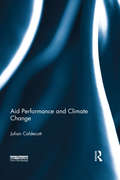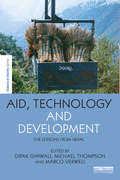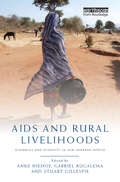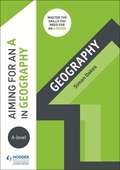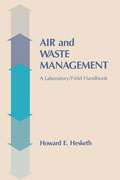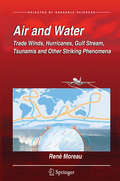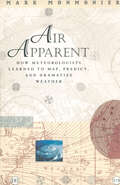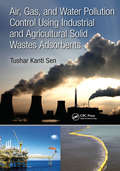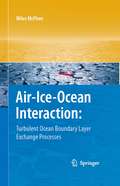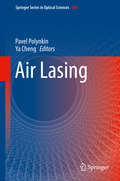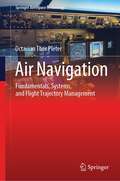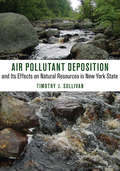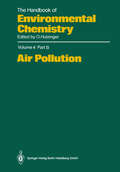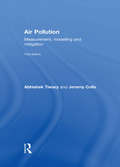- Table View
- List View
Aid and Development (Routledge Perspectives on Development)
by John Overton Warwick E. MurrayThis book provides an overview of what aid is, how it has changed over time and how it is practiced, as well as debates about whether aid works, for whom and what its future might be. The text shows how ‘aid’ is a contested and fluid concept that involves a wide and changing variety of policies, actors and impacts. It equips the reader with an understanding of what aid is, where it comes from and where it goes, how it is delivered and what its impacts are, and whether shortcomings are a result of a fundamental problem with aid, or merely the result of bad practices. It explores the changing political ideologies and conceptions of development that continually reshape how aid is defined, implemented and assessed, and how, despite a global commitment to the Sustainable Development Goals, we are at a point where the very notion of aid is being questioned and its future is uncertain. Each chapter includes case studies, chapter summaries, discussions, weblinks and further reading, to help strengthen the reader’s understanding. Aid and Development provides an important resource for students, development workers and policy makers seeking an understanding of how aid works.
Aid and Development: The Inverse Sovereignty Effect In The Pacific Islands (Routledge Perspectives on Development)
by John Overton Warwick E. MurrayThis book provides an overview of what aid is, how it has changed over time and how it is practiced, as well as debates about whether aid works, for whom and what its future might be. The text shows how ‘aid’ is a contested and fluid concept that involves a wide and changing variety of policies, actors and impacts. It equips the reader with an understanding of what aid is, where it comes from and where it goes, how it is delivered and what its impacts are, and whether shortcomings are a result of a fundamental problem with aid, or merely the result of bad practices. It explores the changing political ideologies and conceptions of development that continually reshape how aid is defined, implemented and assessed, and how, despite a global commitment to the Sustainable Development Goals, we are at a point where the very notion of aid is being questioned and its future is uncertain. Each chapter includes case studies, chapter summaries, discussions, weblinks and further reading, to help strengthen the reader’s understanding. Aid and Development provides an important resource for students, development workers and policy makers seeking an understanding of how aid works.
Aid for Trade: 2nd World Report on Regional Integration (United Nations University Series on Regionalism #2)
by Lakshmi Puri Philippe LombaerdeAid for Trade (AfT) has become a major item on the international trade and development discourse. This is to a large extent in response to concerns expressed by developing countries and economies in transition with regard to their capacities to implement trade agreements, especially WTO agreements, and undertake necessary adjustments to increase net development gains from emerging trade opportunities. In this World Report, major UN agencies active in development cooperation and longstanding providers of trade-related technical assistance and capacity building discuss ways to sustain the momentum towards the operationalization and implementation of the AfT initiative and the supportive role to be played by the UN system. This is consistent with UN's role in promoting development and helping to achieve poverty reduction, as committed in the Millennium Declaration and the 2005 World Summit Outcome. The Report should be of particular interest to government officials, officials of regional organizations, representatives of the private sector dealing with trade agreements and negotiations, civil society and academia. Supachai Panitchpakdi, Secretary-General of UNCTAD Lakshmi Puri is Acting Deputy Secretary-General and Director of the Division on International Trade and Services, and Commodities at UNCTAD in Geneva. Philippe De Lombaerde is Associate Director of United Nations University (UNU-CRIS) in Bruges. In collaboration with: UNCTAD, ECA, ECLAC, ESCAP, ESCWA, UNECE, UNIDO, UNDP, UNEP
Aid, Ownership and Development: The Inverse Sovereignty Effect in the Pacific Islands
by Warwick E. Murray John Overton Gerard Prinsen Tagaloa Avataeao Ulu Nicola WrightonOne of the key principles for effective aid programmes is that recipient agencies exert high degrees of ownership over the agendas, resources, systems and outcomes of aid activities. Sovereign recipient states should lead the process of development. Yet despite this well-recognised principle, the realities of aid delivery mean that ownership is often compromised in practice. Aid, Ownership and Development examines this ‘inverse sovereignty’ hypothesis with regard to the states and territories of the Pacific Island region. It provides an initial overview of different aid ‘regimes’ over time, maps aid flows in the region, and analyses the concept of sovereignty. Drawing on a rich range of primary research by the authors and contributors, it focuses on the agencies and individuals within the Pacific Islands who administer and apply aid projects and programmes. There is indeed evidence for the inverse sovereignty effect; particularly when island states and their small and stretched bureaucracies have to deal with complex and burdensome donor reporting requirements, management systems, consultative meetings and differing strategic priorities. This book outlines important ways in which Pacific agencies have proved adept not only at meeting these requirements, but also asserting their own priorities and ways of operating. It concludes that global agreements, such as the Paris Declaration on Aid Effectiveness in 2005 and the recently launched Sustainable Development Goals, can be effective means for Pacific agencies to both hold donors to account and also to recognise and exercise their own sovereignty.
Aid, Ownership and Development: The Inverse Sovereignty Effect in the Pacific Islands
by Warwick E. Murray John Overton Gerard Prinsen Tagaloa Avataeao Ulu Nicola WrightonOne of the key principles for effective aid programmes is that recipient agencies exert high degrees of ownership over the agendas, resources, systems and outcomes of aid activities. Sovereign recipient states should lead the process of development. Yet despite this well-recognised principle, the realities of aid delivery mean that ownership is often compromised in practice. Aid, Ownership and Development examines this ‘inverse sovereignty’ hypothesis with regard to the states and territories of the Pacific Island region. It provides an initial overview of different aid ‘regimes’ over time, maps aid flows in the region, and analyses the concept of sovereignty. Drawing on a rich range of primary research by the authors and contributors, it focuses on the agencies and individuals within the Pacific Islands who administer and apply aid projects and programmes. There is indeed evidence for the inverse sovereignty effect; particularly when island states and their small and stretched bureaucracies have to deal with complex and burdensome donor reporting requirements, management systems, consultative meetings and differing strategic priorities. This book outlines important ways in which Pacific agencies have proved adept not only at meeting these requirements, but also asserting their own priorities and ways of operating. It concludes that global agreements, such as the Paris Declaration on Aid Effectiveness in 2005 and the recently launched Sustainable Development Goals, can be effective means for Pacific agencies to both hold donors to account and also to recognise and exercise their own sovereignty.
Aid Performance and Climate Change
by Julian CaldecottThe richer countries spend about US$165 billion yearly on overseas aid, mainly to keep human development going. These efforts are undermined by climate change, water-catchment damage, biodiversity loss, and desertification, and their interactions with social systems at all scales, which few aid designs or evaluations fully address. This must change if aid performance is to be improved. Constraints to be overcome include limited understanding of the very complex systems that aid investments affect, and of the ecology behind climate change adaptation and mitigation. Aid Performance and Climate Change targets these problems and others, by explaining how to use multiple points of view to describe each aid investment as a complex system in its own unique context. With examples throughout, it reviews cases, ideas, and options for mitigation using technology and ecology, and for adaptation by preserving resilience and diversity, while exploring related priorities, treaties, and opportunities. Combining an empirical, eye-witness approach with methodological conclusions, this book is an essential resource for those looking to improve aid design and evaluation, and will be a necessary tool in training the next generation of aid professionals to respond to the causes and consequences of climate change.
Aid Performance and Climate Change
by Julian CaldecottThe richer countries spend about US$165 billion yearly on overseas aid, mainly to keep human development going. These efforts are undermined by climate change, water-catchment damage, biodiversity loss, and desertification, and their interactions with social systems at all scales, which few aid designs or evaluations fully address. This must change if aid performance is to be improved. Constraints to be overcome include limited understanding of the very complex systems that aid investments affect, and of the ecology behind climate change adaptation and mitigation. Aid Performance and Climate Change targets these problems and others, by explaining how to use multiple points of view to describe each aid investment as a complex system in its own unique context. With examples throughout, it reviews cases, ideas, and options for mitigation using technology and ecology, and for adaptation by preserving resilience and diversity, while exploring related priorities, treaties, and opportunities. Combining an empirical, eye-witness approach with methodological conclusions, this book is an essential resource for those looking to improve aid design and evaluation, and will be a necessary tool in training the next generation of aid professionals to respond to the causes and consequences of climate change.
Aid, Technology and Development: The Lessons from Nepal (The Earthscan Science in Society Series)
by Dipak Gyawali, Michael Thompson and Marco VerweijOver the last 50 years, Nepal has been considered an experiential model in determining the effectiveness and success of global human development strategies, both in theory and in practice. As such, it provides a rich array of in-depth case studies in both development success and failure. This edited collection examines these in order to propose a novel perspective on how human development occurs and how it can be aided and sustained. Aid, Technology and Development: The lessons from Nepal champions plural rationality from both a theoretical and practical perspective in order to challenge and critique the status quo in human development understanding, while simultaneously presenting a concrete framework with which to aid citizen and governmental organisations in the galvanization of human development. Including contributions by leading international social scientists and development practitioners throughout Nepal, this book will be of great interest to students, scholars and practitioners working in the field of foreign aid and development studies.
Aid, Technology and Development: The Lessons from Nepal (The Earthscan Science in Society Series)
by Dipak Gyawali Michael Thompson Marco VerweijOver the last 50 years, Nepal has been considered an experiential model in determining the effectiveness and success of global human development strategies, both in theory and in practice. As such, it provides a rich array of in-depth case studies in both development success and failure. This edited collection examines these in order to propose a novel perspective on how human development occurs and how it can be aided and sustained. Aid, Technology and Development: The lessons from Nepal champions plural rationality from both a theoretical and practical perspective in order to challenge and critique the status quo in human development understanding, while simultaneously presenting a concrete framework with which to aid citizen and governmental organisations in the galvanization of human development. Including contributions by leading international social scientists and development practitioners throughout Nepal, this book will be of great interest to students, scholars and practitioners working in the field of foreign aid and development studies.
AIDS and Rural Livelihoods: Dynamics and Diversity in sub-Saharan Africa
by Stuart Gillespie Anke Niehof Gabriel RugalemaAIDS epidemics continue to threaten the livelihoods of millions of people in sub-Saharan Africa. Three decades after the disease was first recognized, the annual death toll from AIDS exceeds that from wars, famine and floods combined. Yet despite millions of dollars of aid and research, there has previously been little detailed on-the-ground analysis of the multifaceted impacts on rural people. Filling that gap, this book brings together recent evidence of AIDS impacts on rural households, livelihoods, and agricultural practice in sub-Saharan Africa. There is particular emphasis on the role of women in affected households, and on the situation of children. The book is unique in presenting micro-level information collected by original empirical research in a range of African countries, and showing how well-grounded conclusions on trends, impacts and local responses can be applied to the design of HIV-responsive policies and programmes. AIDS impacts are more diverse than we previously thought, and local responses more varied - sometimes innovative, sometimes desperate. The book represents a major contribution to our understanding of the impacts of AIDS in the epidemic's heartland, and how these can be managed at different levels.
Aiming for an A in A-level Geography
by Simon OakesExam board: AQA, Edexcel, OCR, WJEC, WJEC EduqasLevel: A-levelSubject: GeographyFirst teaching: September 2016First exams: Summer 2018Master the skills you need to set yourself apart and hit the highest grades. This year-round course companion develops the higher-order thinking skills that top-achieving students possess, providing step-by-step guidance, examples and tips for getting an A grade.Written by experienced author, teacher and lecturer Simon Oakes, Aiming for an A in A-level Geography:- Develops the 'A grade skills' of analysis, evaluation, creation and application, ensuring that you know how to apply these skills and approach each exam question as an A/A* candidate- Takes you step by step through the specific skills you need to master in A-level Geography, including geographical reading, data analysis and skills for the Independent Investigation (NEA)- Clearly shows how to move up the grades with sample responses that have been annotated to highlight the key features of A/A* answers- Puts the theory behind achieving an A grade into practice, providing in-class or homework activities and further reading tasks that stretch towards university-level study- Perfects exam technique through practical tips and examples of common pitfalls to avoid- Cultivates effective revision habits for success, with tips and strategies for producing and using revision resources- Supports the major exam boards, outlining the Assessment Objectives for reaching the higher levels under the AQA, Edexcel, OCR and WJEC/Eduqas specifications
Air and Waste Management: A Laboratory and Field Handbook
by Howard D. HeskethThis manual will serve a useful function in training and giving experience to environmental scientists at all levels. Included in this manual are explanatory materials, exercises and experiments. These are intended as training guides. The users of this manual will find it possible to use simple equipment and naturally occurring events to construct some of the needed equipment but may also find it necessary to use commercially available equipment with some of the procedures.
Air and Waste Management: A Laboratory and Field Handbook
by Howard D. HeskethThis manual will serve a useful function in training and giving experience to environmental scientists at all levels. Included in this manual are explanatory materials, exercises and experiments. These are intended as training guides. The users of this manual will find it possible to use simple equipment and naturally occurring events to construct some of the needed equipment but may also find it necessary to use commercially available equipment with some of the procedures.
Air and Water: Trade Winds, Hurricanes, Gulf Stream, Tsunamis and Other Striking Phenomena
by René MoreauAir and water are so familiar that we all think we know them. Yet how difficult it remains to predict their behavior, with so many questions butting against the limits of our knowledge. How are cyclones, tornadoes, thunderstorms, tsunamis or floods generated — sometimes causing devastation and death? What will the weather be tomorrow, next week, next summer? This book brings some answers to these questions with a strategy of describing before explaining. Starting by considering air and water in equilibrium (i.e., at rest), it progresses to discuss dynamic phenomena first focusing on large scale structures, such as El Niño or trade winds, then on ever smaller structures, such as low-pressure zones in the atmosphere, clouds, rain, as well as tides and waves. It finishes by describing man-made constructions (dams, ports, power plants, etc.) that serve to domesticate our water resources and put them to work for us. Including over one hundred illustrations and very few equations, most of the text is accessible to readers with no more than high-school science and who are at ease with quantities such as the temperature of a fluid or the pressure within such a medium. Beyond the primary audience of engineers, teachers, and students, the book is thus also addressed to walkers, hikers, navigators, and all nature lovers.
Air Apparent: How Meteorologists Learned to Map, Predict, and Dramatize Weather
by Mark MonmonierWeather maps have made our atmosphere visible, understandable, and at least moderately predictable. In Air Apparent Mark Monmonier traces debates among scientists eager to unravel the enigma of storms and global change, explains strategies for mapping the upper atmosphere and forecasting disaster, and discusses efforts to detect and control air pollution. Fascinating in its scope and detail, Air Apparent makes us take a second look at the weather map, an image that has been, and continues to be, central to our daily lives. "Clever title, rewarding book. Monmonier . . . offers here a basic course in meteorology, which he presents gracefully by means of a history of weather maps." —Scientific American "Mark Monmonier is onto a winner with Air Apparent. . . . It is good, accessible science and excellent history. . . . Read it." —Fred Pearce, New Scientist "[Air Apparent] is a superb first reading for any backyard novice of weather . . . but even the veteran forecaster or researcher will find it engaging and, in some cases, enlightening." —Joe Venuti, Bulletin of the American Meteorological Society "Monmonier is solid enough in his discussion of geographic and meteorological information to satisfy the experienced weather watcher. But even if this information were not presented in such a lively and engaging manner, it would still hook most any reader who checks the weather map every morning or who sits happily entranced through a full cycle of forecasts on the Weather Channel."—Michael Kennedy, Boston Globe
Air, Gas, and Water Pollution Control Using Industrial and Agricultural Solid Wastes Adsorbents
by Tushar Kanti SenAir and water pollution occurs when toxic pollutants of varying kinds (organic, inorganic, radioactive and so on) are directly or indirectly discharged into the environment without adequate treatment to remove these potential pollutants. There are a total of 13 book chapters in three sections contributed by significant number of expert authors around the world, aiming to provide scientific knowledge and up-to-date development of various solid wastes based cost-effective adsorbent materials and its sustainable application in the removal of contaminates/pollutants from air, gas and water. This book is useful for the professions, practicing engineers, scientists, researchers, academics and undergraduate and post-graduate students’ interest on this specific area. Key Features: • Exclusive compilation of information on use of industrial and agricultural waste based adsorbents for air and water pollution abatement. • Explores utilization of industrial solid wastes in adsorptive purification and agricultural and agricultural by-products in separation and purification. • Discusses cost-effective solid wastes based emerging adsorbents. • Alternative adsorbents in the removal of a wide range of contaminants and pollutants from water is proposed. • Includes performance of unit operations in waste effluents treatment.
Air, Gas, and Water Pollution Control Using Industrial and Agricultural Solid Wastes Adsorbents
by Tushar Kanti SenAir and water pollution occurs when toxic pollutants of varying kinds (organic, inorganic, radioactive and so on) are directly or indirectly discharged into the environment without adequate treatment to remove these potential pollutants. There are a total of 13 book chapters in three sections contributed by significant number of expert authors around the world, aiming to provide scientific knowledge and up-to-date development of various solid wastes based cost-effective adsorbent materials and its sustainable application in the removal of contaminates/pollutants from air, gas and water. This book is useful for the professions, practicing engineers, scientists, researchers, academics and undergraduate and post-graduate students’ interest on this specific area. Key Features: • Exclusive compilation of information on use of industrial and agricultural waste based adsorbents for air and water pollution abatement. • Explores utilization of industrial solid wastes in adsorptive purification and agricultural and agricultural by-products in separation and purification. • Discusses cost-effective solid wastes based emerging adsorbents. • Alternative adsorbents in the removal of a wide range of contaminants and pollutants from water is proposed. • Includes performance of unit operations in waste effluents treatment.
Air-Ice-Ocean Interaction: Turbulent Ocean Boundary Layer Exchange Processes
by Miles McPheeAt a time when the polar regions are undergoing rapid and unprecedented change, understanding exchanges of momentum, heat and salt at the ice-ocean interface is critical for realistically predicting the future state of sea ice. By offering a measurement platform largely unaffected by surface waves, drifting sea ice provides a unique laboratory for studying aspects of geophysical boundary layer flows that are extremely difficult to measure elsewhere. This book draws on both extensive observations and theoretical principles to develop a concise description of the impact of stress, rotation, and buoyancy on the turbulence scales that control exchanges between the atmosphere and underlying ocean when sea ice is present. Several interesting and unique observational data sets are used to illustrate different aspects of ice-ocean interaction ranging from the impact of salt on melting in the Greenland Sea marginal ice zone, to how nonlinearities in the equation of state for seawater affect mixing in the Weddell Sea. The book’s content, developed from a series of lectures, may be appropriate additional material for upper-level undergraduates and first-year graduate students studying the geophysics of sea ice and planetary boundary layers.
Air Lasing (Springer Series in Optical Sciences #208)
by Pavel Polynkin Ya ChengThis book presents the first comprehensive, interdisciplinary review of the rapidly developing field of air lasing. In most applications of lasers, such as cutting and engraving, the laser source is brought to the point of service where the laser beam is needed to perform its function. However, in some important applications such as remote atmospheric sensing, placing the laser at a convenient location is not an option. Current sensing schemes rely on the detection of weak backscattering of ground-based, forward-propagating optical probes, and possess limited sensitivity. The concept of air lasing (or atmospheric lasing) relies on the idea that the constituents of the air itself can be used as an active laser medium, creating a backward-propagating, impulsive, laser-like radiation emanating from a remote location in the atmosphere. This book provides important insights into the current state of development of air lasing and its applications.
Air Masses that Affect Weather in the UK (tactile)
by RnibThis is a tactile diagram for GCSE level students. The map of the UK is shown, with arrows indicating the direction of various air masses towards the UK. The UK is textured.
Air Navigation: Fundamentals, Systems, and Flight Trajectory Management (Springer Aerospace Technology)
by Octavian Thor PleterThis book takes a new approach to air navigation, extending the classic scope of positioning and guidance to efficient and safe 4D flight trajectory management. Modern air navigation aims at flight trajectories optimisation. There is an infinite number of solutions to the classic navigation problem of flying from one airport to another, but most of them are wasteful of resources and even risky. Minimising all costs and risks incurred by the 4D flight trajectory makes air navigation both efficient and safe, which are key factors in air navigation services. Beyond minimising fuel burn and CO2, efficiency addresses non-CO2 emissions and noise. This is a visually intensive book, using examples and case studies to illustrate the concepts, the physics of navigation and the mathematical models involved. Numerical examples reflect its problem-solving nature. It is useful to aerospace students, engineers, pilots, air traffic controllers, technicians, and scientists curious about aviation.
Air Pollutant Deposition and Its Effects on Natural Resources in New York State
by Timothy J. SullivanEcosystem effects from air pollution in the Adirondacks, Catskills, and elsewhere in New York have been substantial. Efforts to characterize and quantify these impacts, and to examine more recent recovery, have focused largely on surface waters, soils, and forests. Lakes, streams, and soils have acidified. Estuaries have become more eutrophic. Nutrient cycles have been disrupted. Mercury has bioaccumulated to toxic levels. Plant species composition has changed. Some surface waters show signs of partial chemical recovery in response to emissions control programs, but available data suggest that soil chemistry may continue to deteriorate under expected future emissions and deposition. Resource managers, policymakers, and scientists now need to know the extent to which current and projected future emissions reductions will lead to ecosystem recovery.In this book, Timothy J. Sullivan provides a comprehensive synthesis of past, current, and potential future conditions regarding atmospheric sulfur, nitrogen oxides, ammonium, and mercury deposition; surface water chemistry; soil chemistry; forests; and aquatic biota in New York, providing much needed information to help set emissions reduction goals, evaluate incremental improvements, conduct cost/benefit analyses, and prioritize research needs. He draws upon a wealth of research conducted over the past thirty years that has categorized, quantified, and advanced understanding of ecosystem processes related to atmospheric deposition of strong acids, nutrients, and mercury and associated ecosystem effects. An important component of this volume is the new interest in the management and mitigation of ecosystem damage from air pollution stress, which builds on the "critical loads" approach pioneered in Europe and now gaining interest in the United States. This book will inform scientists, resource managers, and policy analysts regarding the state of scientific knowledge on these complex topics and their policy relevance and will help to guide public policy assessment work in New York, the Northeast, and nationally.
Air Pollution (The Handbook of Environmental Chemistry #4 / 4B)
by H. Brauer J. S. Gaffney R. Harkov M.A.K. Khalil F. W. Lipfert N. A. Marley E. W. Prestbo G. E. ShawAn important purpose of The Handbook of Environmental Chemistry is to aid the understanding of distribution and chemical reaction processes which occur in the environment. Volume 4, Part B of this series is dedicated to Air Pollution Control Equipment, Materials Damage, Peroxyacyl Nitrates, Semivolatile Compounds in the Atmosphere, and Arctic Haze.
Air Pollution: Measurement, Modelling and Mitigation, Third Edition
by Jeremy Colls Abhishek TiwaryA one stop, comprehensive textbook, covering the three essential components of air pollution science. The Third Edition has been updated with the latest developments, especially the inclusion of new information on the role of air pollutants in climate change. The authors give greater coverage to the developing economies around the world where air pollution problems are on the rise. The Third Edition continues to cover a wide range of air quality issues, retaining a quantitative perspective. Topics covered include - gaseous and particulate air pollutants, measurement techniques, meteorology and dispersion modelling, mobile sources, indoor air, effects on plants, materials, humans and animals. Moving away from classical toxic air pollutants, there is a chapter on climate change and another on the depletion of stratospheric ozone. A special feature of this new edition is the inclusion of a fresh chapter on air pollution mitigation by vegetation, mainly its role in maintaining a sustainable urban environment. Recommended for upper-level undergraduate and postgraduate courses specialising in air pollution, both for environmental scientists and engineers. The new material included in the Third Edition extends its use by practitioners in consultancies or local authorities.
Air Pollution: Measurement, Modelling and Mitigation, Third Edition
by Jeremy Colls Abhishek TiwaryA one stop, comprehensive textbook, covering the three essential components of air pollution science. The Third Edition has been updated with the latest developments, especially the inclusion of new information on the role of air pollutants in climate change. The authors give greater coverage to the developing economies around the world where air pollution problems are on the rise. The Third Edition continues to cover a wide range of air quality issues, retaining a quantitative perspective. Topics covered include - gaseous and particulate air pollutants, measurement techniques, meteorology and dispersion modelling, mobile sources, indoor air, effects on plants, materials, humans and animals. Moving away from classical toxic air pollutants, there is a chapter on climate change and another on the depletion of stratospheric ozone. A special feature of this new edition is the inclusion of a fresh chapter on air pollution mitigation by vegetation, mainly its role in maintaining a sustainable urban environment. Recommended for upper-level undergraduate and postgraduate courses specialising in air pollution, both for environmental scientists and engineers. The new material included in the Third Edition extends its use by practitioners in consultancies or local authorities.
